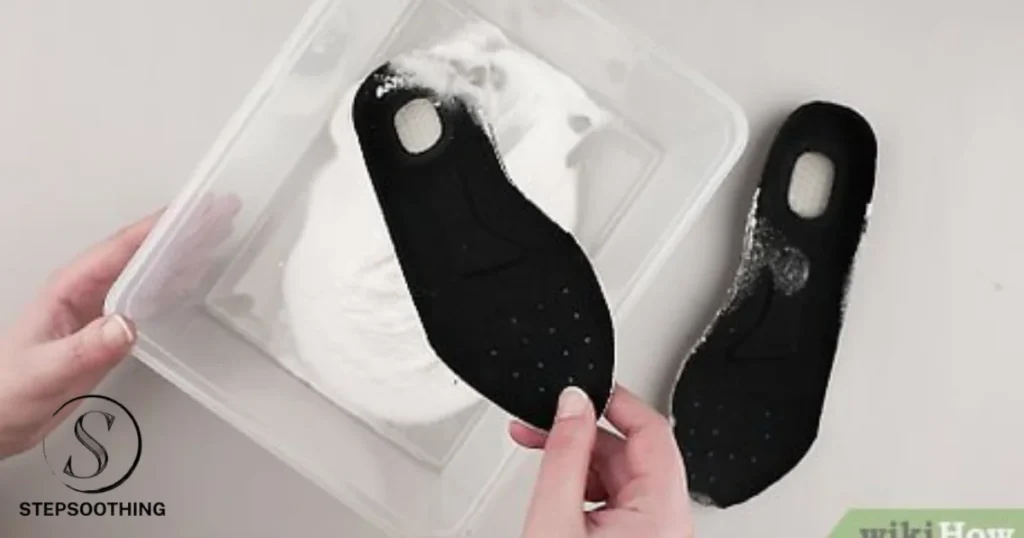Insoles are essential components of footwear that provide cushioning, support, and comfort to our feet. Proper care and maintenance of insoles are crucial to ensure their longevity and effectiveness. In this article, we will discuss the importance of proper care and maintenance of insoles, the different types of insoles, and various techniques to keep them in top condition.

Proper Care and Maintenance of Insoles
Insoles are removable pads or supports that are placed inside shoes to provide cushioning, support, and comfort to the feet. They are designed to help alleviate foot pain, improve posture, and enhance overall foot health.
A. Importance of Proper Care and Maintenance
Proper care and maintenance of insoles are essential for several reasons:
- Extending the lifespan of insoles: Regular cleaning and maintenance can help prevent wear and tear, ensuring that your insoles last longer.
- Maintaining comfort and support: Well-maintained insoles provide better cushioning and support, reducing the risk of foot-related issues such as plantar fasciitis, arch pain, and heel spurs.
- Preventing odor and bacteria buildup: Regular cleaning helps eliminate odor-causing bacteria, keeping your insoles fresh and hygienic.
- Enhancing the overall appearance of your shoes: Properly maintained insoles can help maintain the appearance of your shoes, ensuring they look new for longer.
B. Overview of the Benefits of Well-Maintained Insoles
Well-maintained insoles offer several benefits, including:
- Improved comfort: Well-maintained insoles provide better cushioning and support, reducing the risk of foot-related issues and discomfort.
- Enhanced foot health: Properly maintained insoles can help improve posture, reduce stress on the feet, and promote overall foot health.
- Increased shoe lifespan: Well-maintained insoles can help extend the lifespan of your shoes by preventing wear and tear.
- Reduced risk of injury: Well-maintained insoles can help reduce the risk of foot-related injuries by providing proper support and cushioning.

Types of Insoles
There are several types of insoles available, each designed to address specific foot issues and provide different levels of support and cushioning. Some common types of insoles include:
A. Different Materials used in Insoles
Insoles are made from various materials, each with its unique properties and benefits:
- Cushioned insoles: These insoles are made from soft, cushioning materials like foam or gel, providing excellent shock absorption and comfort.
- Arch support insoles: These insoles are designed to provide additional support to the arches of the feet, helping to alleviate arch pain and improve posture.
- Gel insoles: These insoles are made from a gel-like material that provides excellent cushioning and shock absorption, making them ideal for those with active lifestyles.
- Orthotic insoles: These insoles are custom-made to address specific foot issues and provide targeted support and cushioning.
B. Common types of Insoles
Some common types of insoles include:
- Cushioned insoles: These insoles are made from soft, cushioning materials like foam or gel, providing excellent shock absorption and comfort.
- Arch support insoles: These insoles are designed to provide additional support to the arches of the feet, helping to alleviate arch pain and improve posture.
- Gel insoles: These insoles are made from a gel-like material that provides excellent cushioning and shock absorption, making them ideal for those with active lifestyles.
- Orthotic insoles: These insoles are custom-made to address specific foot issues and provide targeted support and cushioning.

Proper Care Techniques
Proper care techniques are essential to maintain the cleanliness, integrity, and effectiveness of your insoles. Here are some key techniques to ensure your insoles remain in top condition:
A. Cleaning methods for Various Types of Insoles
Different types of insoles require specific cleaning methods to prevent damage and maintain their performance:
- Foam or fabric insoles: These can be gently hand-washed with mild soap and water, ensuring thorough rinsing and proper drying to prevent mold growth.
- Gel insoles: Wipe these with a damp cloth and mild soap, avoiding soaking them to prevent damage to the gel material.
- Leather insoles: Use a damp cloth to wipe these clean, avoiding excessive moisture that can damage the leather.
B. Drying Techniques to Prevent Damage
Proper drying techniques are crucial to prevent mold growth and maintain the structural integrity of your insoles:
- Air drying: Place your insoles in a well-ventilated area away from direct heat sources to allow them to air dry naturally.
- Use of absorbent materials: Placing paper towels or absorbent cloths inside your shoes can help absorb excess moisture and speed up the drying process.
C. Storage Tips to Maintain Longevity
Proper storage is key to maintaining the shape and integrity of your insoles:
- Store in a cool, dry place: Avoid storing your shoes with insoles in damp or humid areas that can promote mold growth.
- Use shoe trees: Inserting shoe trees into your shoes when not in use can help maintain their shape and prevent deformation of the insoles.

Maintenance Practices
Regular maintenance practices are essential to ensure that your insoles remain in optimal condition and continue to provide the support and comfort your feet need. Here are some key maintenance practices to keep your insoles in top shape:
A. Regular inspection for Wear and Tear
Regularly inspecting your insoles for signs of wear and tear can help you identify issues early on and take necessary action:
- Check for visible damage: Look for any tears, cracks, or worn-out areas on your insoles that may affect their performance.
- Inspect for wear patterns: Pay attention to any uneven wear patterns on your insoles, as this can indicate areas of high pressure or improper fit.
B. Replacing Insoles when Necessary
Knowing when to replace your insoles is crucial to ensure that they continue to provide adequate support and cushioning:
- Consider the lifespan: Insoles have a limited lifespan depending on their material and usage, so it’s essential to replace them when they show signs of significant wear.
- Listen to your feet: If you experience discomfort, pain, or reduced support while wearing your shoes, it may be time to replace your insoles.
C. Extending the lifespan of Insoles
Taking proactive steps to extend the lifespan of your insoles can help you get the most out of them:
- Rotate between multiple pairs: Using multiple pairs of insoles and rotating them regularly can help distribute wear evenly and prolong their lifespan.
- Use protective covers: Consider using protective covers or inserts to shield your insoles from excessive moisture, friction, and wear.

Troubleshooting Common Issues
Troubleshooting common issues with insoles can help you address discomfort, odors, and other concerns effectively. Here are some common issues and their respective troubleshooting tips:
A. Dealing with Odors and Bacteria
Odors and bacteria buildup can be a common issue with insoles. Here are some tips to address this:
- Regular cleaning: Regularly clean your insoles using appropriate methods based on their material composition to prevent odor buildup and maintain hygiene.
- Use of odor-absorbing materials: Consider using odor-absorbing materials like baking soda or activated charcoal to help neutralize odors and reduce bacteria growth.
- Air drying: Ensure proper drying of your insoles after cleaning to prevent mold growth and odor-causing bacteria.
B. Fixing Discomfort or Lack of Support
Discomfort or lack of support can be caused by various factors, including improper fit, worn-out insoles, or incorrect usage. Here are some tips to address these issues:
- Proper fit: Ensure that your insoles fit snugly in your shoes without causing discomfort or pressure points.
- Replace worn-out insoles: If your insoles show signs of significant wear, it may be time to replace them to ensure proper support and cushioning.
- Correct usage: Follow the manufacturer’s instructions for proper usage of your insoles to ensure they provide the intended support and cushioning.
C. Addressing Wear Patterns
Wear patterns can indicate areas of high pressure or improper fit. Here are some tips to address these issues:
- Adjust shoe fit: If you notice uneven wear patterns, consider adjusting the fit of your shoes to distribute pressure evenly across the insoles.
- Replace insoles: If wear patterns persist despite adjustments to your shoe fit, it may be time to replace your insoles to ensure proper support and cushioning.
- Use protective covers: Consider using protective covers or inserts to shield your insoles from excessive moisture, friction, and wear.

DIY Insole Care Recipes
DIY insole care recipes offer natural and cost-effective solutions to maintain the cleanliness and effectiveness of your insoles. Here are some simple and effective recipes you can try at home:
A. Homemade Cleaning Solutions
- Vinegar and Water Solution:
- Mix equal parts white vinegar and water in a spray bottle.
- Lightly spray the solution on your insoles and wipe them clean with a damp cloth.
- Allow the insoles to air dry thoroughly before placing them back in your shoes.
- Baking Soda Paste:
- Create a paste using baking soda and water.
- Apply the paste to your insoles, gently scrubbing to remove dirt and odors.
- Rinse off the paste with water and let the insoles dry completely.
B. Natural Deodorizers for Insoles
- Essential Oil Sachets:
- Fill small sachets with dried herbs like lavender or cedar chips.
- Add a few drops of essential oils like tea tree or peppermint for additional freshness.
- Place the sachets inside your shoes when not in use to absorb odors and keep them smelling fresh.
- Activated Charcoal Inserts:
- Place activated charcoal inserts inside your shoes to absorb moisture and neutralize odors.
- Leave the inserts overnight to allow them to work effectively.
By incorporating these DIY insole care recipes into your routine, you can effectively clean, deodorize, and maintain the freshness of your insoles using natural ingredients that are gentle yet powerful.

Professional Maintenance Services
Professional maintenance services for insoles offer specialized care to enhance longevity and performance, addressing specific issues with expertise.
Here are some benefits of opting for professional maintenance services:
A. When to Seek Professional help for Insole Care
Knowing when to seek professional help for your insoles is essential to address complex issues or when DIY methods may not suffice. Insoles are essential for foot comfort, support, and stability. Proper maintenance ensures their longevity and effectiveness.
Additionally, they are designed to help alleviate foot pain, improve posture, and enhance overall foot health. By considering professional maintenance services for your insoles when needed, you can benefit from expert care that goes beyond DIY methods to address complex issues, restore functionality, and prolong the lifespan of your footwear accessories.
Follow outlined practices, tips, and techniques for cleanliness, freshness, and functionality. Enhance your walking experience with care and maintenance of your insoles.
- Persistent odors or stains: If DIY cleaning methods fail to eliminate persistent odors or stains from your insoles, professional cleaning services can provide more thorough solutions.
- Structural damage: In cases of significant structural damage like tears, cracks, or deformities, professional repair services can help restore the integrity of your insoles.
B. Benefits of Professional Cleaning and Maintenance
Professional cleaning and maintenance services offer several benefits that can enhance the effectiveness and lifespan of your insoles:
- Deep cleaning: Professional services use specialized equipment and techniques to deep clean your insoles, removing embedded dirt, bacteria, and odors effectively.
- Repair and restoration: Professional technicians can repair structural damage, replace worn-out components, and restore the functionality of your insoles to like-new condition.
- Customized solutions: Professionals can provide customized solutions tailored to your specific foot needs, ensuring optimal support, cushioning, and comfort.
By considering professional maintenance services for your insoles when needed, you can benefit from expert care that goes beyond DIY methods to address complex issues, restore functionality, and prolong the lifespan of your footwear accessories.
Conclusion
Insoles are vital for foot comfort, support, and stability. Proper maintenance ensures their longevity and effectiveness. Follow outlined practices, tips, and techniques for cleanliness, freshness, and functionality. Enhance overall foot health and walking experience with care and maintenance of your insoles.
A. Recap of the Importance of Caring for Insoles
Proper care and maintenance of insoles are vital for several reasons:
- Longevity: Regular cleaning, inspection, and replacement when necessary can extend the lifespan of your insoles.
- Comfort: Well-maintained insoles provide better cushioning and support, reducing the risk of foot-related issues.
- Hygiene: Regular cleaning helps prevent odor buildup and maintains hygiene levels for healthier feet.
B. Final Tips for Maintaining Healthy and Durable Insoles
To ensure your insoles remain in top condition:
- Follow a regular cleaning routine: Clean your insoles regularly using appropriate methods based on their material composition.
- Inspect for wear and tear: Regularly check your insoles for signs of damage or wear patterns to address issues early on.
- Seek professional help when needed: Consider professional maintenance services for complex issues or specialized care requirements.
By incorporating these final tips into your insole care routine, you can enjoy comfortable, supportive, and durable insoles that enhance your overall foot health and well-being.
In conclusion, caring for your insoles is not just about maintaining footwear accessories; it’s about prioritizing your foot health, comfort, and overall well-being. By investing time and effort into proper care and maintenance practices, you can ensure that your insoles continue to provide the support and cushioning your feet need to stay healthy and happy.
Remember, healthy feet start with well-cared-for insoles!



